There’s a lot of fantastic game media being produced right now, not to mention buckets of creative people making game related stuff. I wondered, what goes into the making of an end product from start to finish? Be it an article, podcast, video or perhaps even a game upgrade of some sort, there is a lot of work poured into it. I reached out to some folks in this hobby game media and content creation industry to see how they approach their making, and how they (and we!) make for your eyes, ears and hands. This week and next, I’ll be highlighting some of these folks in the community so you can learn a little more about them and what they do: it encompasses a lot, but I feel like “a day in the life of” is an appropriate approach here!

Rafael Cordero, Ding & Dent
Written content is one of the more niche aspects of board game media creation, and one that we’re obviously invested here at the Daily Worker Placement. We have a core team of 3 writers here, with a number of guests who pop in now and then. Sean, David and myself coordinate to generally put out three articles a week, and we’re really pleased with how our skills and readership have grown over the last couple of years – thanks to a lot of you all. There’s a pretty great range of written outlets for board game reviews and other content now, so I reached out to a few writers to get their perspectives on the work. Let’s hear from Rafael Cordero and Charlie Theel from Ding & Dent (plus Miniature Market’s Review Corner and Geek & Sundry), Ruel Gaviola from iSlaytheDragon (plus Geek & Sundry, too!) and Eric Yurko from What’s Eric Playing.
I started off by asking these folks how they got into the writing game – Charlie had started writing as a music critic, and “after being in the board game hobby for a number of years, I came to the conclusion that I could offer a unique and well-written perspective.” His friend Raf had started writing short reviews on BoardGameGeek, which led to creating Ding & Dent on a whim with Charlie, and then further down the line being able to “write things outside of a review format” with Geek & Sundry. Charlie set out to definitely create for others to consume, and formed the Miniature Market’s Review Corner team, to “create content for readers to digest … and not simply write for myself.” Ruel came at things through consuming content, and when an opportunity came up for a news person at iSlaytheDragon.com he applied and got in, eventually moving to “reviewing games, then I started writing about games on my blog and looking for other outlets for my writing, which led me to working with Geek & Sundry.” Eric’s work came about after he found himself a graduate with a new job, and settling in he found himself looking for a creative task to work on. He started writing because his “ housemate who used to explain all the games moved out and I needed to kind of clear out a bunch of rules explanations that were rattling around in my head. Writing helped me better lock them down,” and once he considered improving his photography the content and brand followed.
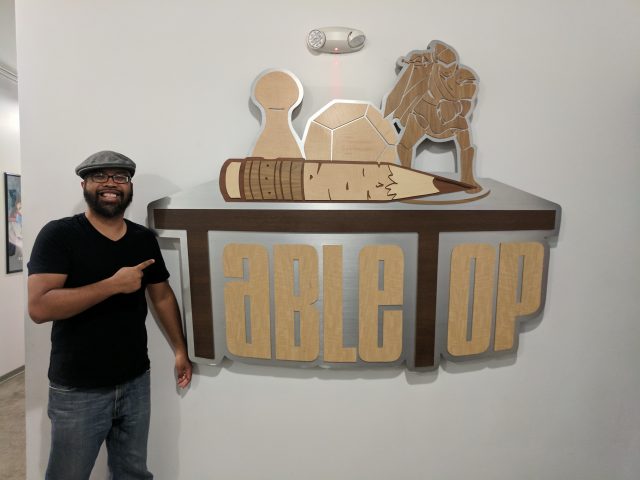
Ruel Gaviola, iSlaytheDragon
It seems that, for the most part, people’s interest in the hobby ends up intensifying to a point where it starts to manifest all of a sudden as creating output such as writing and photography. It’s pretty much what happened with the DWP – things falling into place. Creating can be born out of the hobby, but what about the rest of these creators lives? Considering producing this can take a reasonable amount of time, I wondered what these folks do for a day job on top of hobby jobs. Interestingly, both Charlie and Eric work in software engineering and development, and Raf is a Reliability Engineer, focusing on Fixed Equipment in a chemical plant (that means it’s his job to keep it from failing, “and if it does fail to figure out how to fix it and prevent it from happening again. Also to keep us compliant with the law.”) Both Raf and Eric found the creativity of their board game writing a great complement to the more technical or logical aspects of their jobs. Thinking about, and articulating, what you find compelling about the games you play and the hobby overall definitely inspires creativity.
So, given the amount of games we all likely play, how are the decisions made on what to write about, and what is important to cover? Be interested, be inspired, keep things fresh. While Charlie and Raf both keep an eye out on what’s happening in the industry and researching upcoming releases, it often boils down to, as Charlie puts it: games I am interested in,” as the primary determinant, including “thematic games that tell great stories, and whatever else catches my eye.” And even though review copies mean commitment to writing on certain things, Raf will typically “request copies based on games that I’m excited about or seem to have something unique or new they’re bringing to the industry” in order “not to cover every game that releases, but to try to find interesting games doing something new.” Eric will often get in review copies or Kickstarter previews too, so there is some prioritizing there, but will generally pick arbitrarily – but what I found interesting was his point of writing “for the pattern of it – I did a Dominion review every fourth review for a while and an Oink game every eighth; still doing that one, actually” – which is a great way to structure an approach and keep inspired. Ruel often focuses on reporting news and putting out game reviews, but will also “write about different aspects of the hobby, whether it’s a listicle of one- and two-player games or a profile on somebody who’s doing cool things with board games,” which shows just how all-encompassing board game content can be. And while it’s tough to do, he feels “giving the reader a sense of gameplay” is key, and gives kudos to his two editors Jonathan Wolf (iSlaytheDragon) and Teri Litorco (Geek & Sundry) for giving him feedback and direction as far as what to include.

As a static format, there can be limitations with written reviews – how do these creators approach that issue – or do they even see it as such? Ruel makes the great point that “sometimes it’s tough to capture in words how much fun a game is. I remember reading early reviews for Happy Salmon and it sounded “meh.” Playing it was a totally different experience; it was awesome!” In the same vein, Eric’s position is that with certain games it can be tough to find the right approach and “that’s part of the reason you still don’t see my Pandemic Legacy: Season 1 review that I am definitely going to start at some point presumably. It just doesn’t fit my style and I don’t think I can do the right pictures for it.” On the other hand, written content can sometimes be a fresh approach to a creative way to review a game, for instance Charlie “wrote an interactive review of Raxxon where navigating the article and the sense of discovering the review is intended to mimic the journey provided by the game.” And with the inclusion of images and GIFs Raf doesn’t feel limited by the format – which dovetails nicely into something else I asked of these folks: is photography a key component to include in written reviews? It seems practically as well as illustratively, they’re important – not only are they important to illustrate key points, Charlie says, but “even to break up your text into more digestible sections.” Eric concurs, as he is “an extremely wordy reviewer, by trade, so if I just had 4000 words of text on the page nobody would ever read it.” Although it is its own skill, Raf knows “a picture really can be worth 1,000 words, even though it can be a lot of additional work to create powerful images!” The power images have in a written review can be really important in more complex games, and Ruel feels that, “instead of bogging down the reader with long, drawn-out explanations, photos and captions can help make your job easier.” This really resonates with us here at the DWP (just browse around to see Sean’s fantastic shooting!), and as someone who appreciates illustrations, photos and diagrams in board game rules, I feel they’re just as important in reviews!
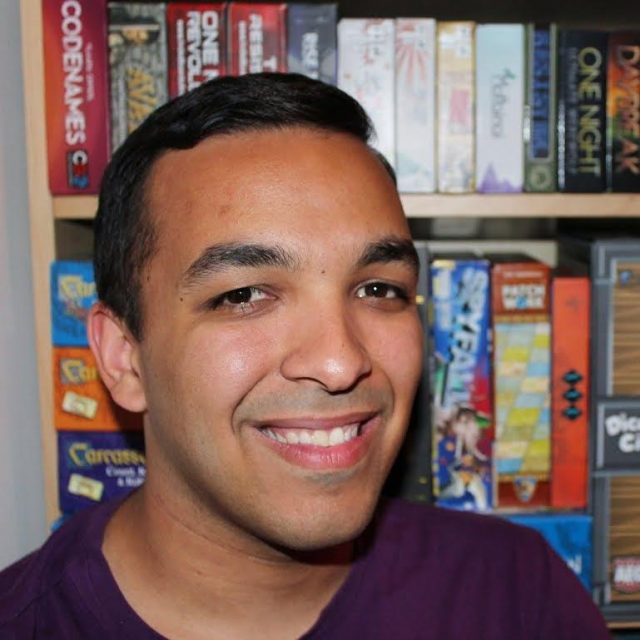
Eric Yurko, What’s Eric Playing?
Beyond the content, who contributes to the sites everyone writes for, and how are all of these pieces coordinated? It’s got to be a bit of a circus. Eric’s got it the easiest out of all of these folks, because it’s just him! “Never thought to ask anyone else. I’d have to change the name from “What’s Eric Playing?” and honestly I agonized about that for two weeks so I’m inclined to just leave it. I do contribute for Punchboard Media, though, and that’s got a whole bamboozle of people.” He does keep the organization of it all “needlessly overcomplicated spreadsheet”, which sounds a lot like me to be honest! But noting down the levels of reviews “like ‘Only Have Pictures,’ ‘Only Needs Pictures,’ ‘Some Sections Written’” is a really smart way of approaching your own work and deadlines. Ruel is able to pitch consistently to the sites he writes for, and whatever doesn’t end up on those will end up on his personal blog; “I occasionally challenge myself to write more on my blog, like writing about a different game each day for a month” which is certainly a way of keeping on top of things and making sure you’re always thinking of content. Charlie and Raf have it a little more complex – Raf says “Charlie and I began writing for D&D as a way to grow the outlet”, and in addition they both write for Miniature Market’s review corner because Miniature Market started sponsoring their podcast, so it was a natural fit. Charlie wrangles all of the folks who writes for the Review Corner but his is a more “complicated answer because I freelance for so many outlets” – not just Ding & Dent/Review Corner, but also Geek and Sundry, Ars Technica and UK outlet Tabletop Gaming. That’s a pretty impressive lineup! For him, “most outlets I write for give me a hard date an article is due by. I fit that in around my work schedule and make sure to never miss a date.” Raf, who also writes for Geek and Sundry on occasion, after Charlie connected him with an editor there, has his own “personal organizational system to track content and I’m constantly figuring out ways to improve it” because every outlet does things a little differently: “from scheduling to actually publishing there is not one way to do it.”
Getting things done overall seems to be geared toward a lot of practical skills in deadline management and organization, but I wanted to know if there were other skills that had been brought along by these creators, or if they’d learnt “on the job” – and what skills and tools they could recommend as creators. Ruel emphasizes that it’s important to have a strong writing foundation, “ you should know basic grammar, sentence structure, and spelling” and even more importantly to have a passion for reading. Similarly, Charlie had a creative writing class in college, and also “used to do a lot of reading which has certainly helped.” Interestingly, as Raf really prefers reading articles to watching videos, he’s picking things up along the way, attempting to “sponge up as much as I can from the great writers that are already in this space.” Not to be biased, but we’re a pretty great community of writers – Raf included! It’s always an inspiration to see what is being put out. Eric dove into creating reviews with photography and image editing skills already, but “everything else I’ve just kind of learned by doing. It’s been a lot of fun!” – and as far as tools go, he suggests making sure you have basic photo editing software, as you really should include photos. Ruel has a background in technical writing, which helped him transition into board game reviews and other writing, and “I was also schooled in journalism and worked in advertising for a few years, so that helped me thrive under deadlines. I may not be the best writer, but I can consistently produce good work.” As far as practical tools for writing, making sure you pick a platform you’re comfortable with and want to stick to is Eric’s suggestion; Raf has been taking notes while playing, which helps enormously when actually coming back to write a piece, and he recommends “having someone to look over your articles if you can. It doesn’t have to be an editor; even a friend you trust to be honest can be a huge help.” If you can’t do that, Charlie’s trick is “writing your article in one content window and then copying it into another format to proof read. By switching tools you can break a mental pattern and evaluate your own work more clearly.”
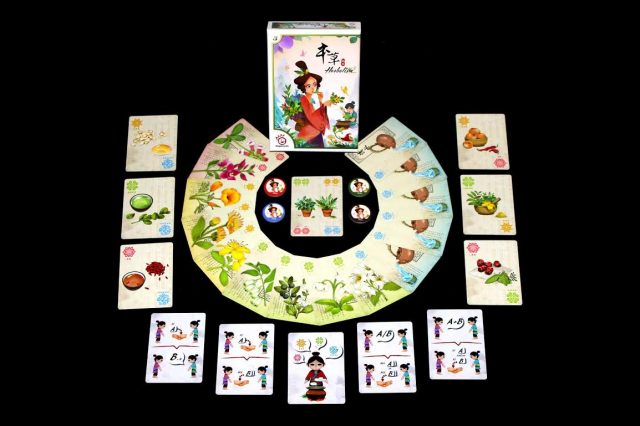
Herbalism, shot by Eric Yurko
So, there’s a lot of work and skills that go into creating written board game content – we’ve seen as much so far! But I think that, in any format there can really be unique challenges that creators face. One that comes with this generally being a hobby or only part time is when to find time to do what you want, which is what Ruel finds his biggest challenge – as do I, frankly! And it’s not just time writing one piece, but writing on all of the games, taking and editing photos – as Eric notes, “not nearly as long as scripting, recording, and editing video, I’d presume, but still time.” More practically, Eric also deals with the “risk of, let’s call it, ‘inadvertent borrowing,’ or where people don’t exactly read the licensing information on photos they get from BoardGameGeek” – so that’s time spent on top of creating content to deal with YouTube, Instagram and Twitter copyright claims. When it comes down to the creative part, Raf and Charlie have a couple of road blocks. For Charlie, who likes to write creatively and with passion, it can be tough to keep things fresh, and when “writing 1-3 reviews a week … it can be challenging to come at a piece from a new angle.” Raf finds his biggest challenge in writing for different outlets; “ Geek & Sundry and The Review Corner have different expectations for how we write and what we write about. Shifting between them is difficult, and so is fulfilling their needs without losing my voice. That makes me a better writer, but it is also something that I have to be conscious of.”
After time and effort and all the challenges, what can keep these writers motivated, and what drives them? Feedback and connection to the community are key. For Charlie, “every time I see a compliment, or someone responds to a Geeklist item in my review collection, I feel that push. Feedback is a huge motivator and when you hear a person or two tell you that you’re their favorite reviewer, that means a lot.” Raf, on top of just having an outlet for the creative part of his brain to write about games, enjoys “knowing that there are people that respect what I have to say and how I say it.” I loved his anecdote about a piece he wrote in Geek & Sundry: “The guy who runs it reached out to say how many people visited the library because of my article and the effect it had on his patreon. Moments like this where I feel like I’ve made a difference in the hobby no matter how small keep me going.” Eric’s experienced positive feedback which helps, but when it comes down to it? “Honestly, I just really like doing it,” he says. For him, overall, the major drive has been he’s “met a lot of awesome people and they’ve been great, so continuing to participate in a great community keeps me going.” Ruel feels similarly – while he loves the hobby and it’s brought him a lot of joy, it’s given him a “unique way to connect with family and friends” and to “meet interesting people and make a few new friends. It’s these friendships that you can’t put a price on and make it worth it for me”. I think the ideas of feedback on your work and connection to the community are truly intertwined here, especially being that there’s so much love going on behind the creation of this content. Passion drives us in the hobby and to create, and our community sees this and reacts in kind. Raf’s sentiment here is really key, in my mind: “Games are a powerful medium and they’ve sometimes blown me away; getting to sit and chat with the people who have created those games is a surreal experience. There is also an amazing community and network of content creators. Getting to be a part of that makes the work worth it.”

Annette Villa, Nettersplays (photo by @DiscordJack)
Switching gears now, we’ve often thought about wading into the pool of video content at the Daily Worker Placement – but it’s really hard to produce more than one type of content and do it consistently at a high quality with a small team. We decided to leave it to the pros, the people who are truly inspired and love to make video content (perhaps in addition to other stuff). I got in touch with Annette Villa from Nettersplays, Caryl Tan and Mandi Hutchinson from To Die For Games, and Christian Kang of Take Your Chits to discuss what goes into their productions, and more.
First up, I asked these folks how they got into the video making situation. Did they set out with it in mind, or did it otherwise sneak up on them? I found it interesting that a common factor among a few folks was the motivation to share their love of the hobby, and provide a perspective they weren’t already seeing. After starting out sharing a few things on Instagram and interacting with the community there, Annette, she wasn’t seeing “many women in the hobby that were creating content and I wanted to contribute a different perspective in my own special way.” For Caryl, it was a way to start communicating her enthusiasm for games to customers of her online store, and really became a goal of bringing “more newcomers to know of all these awesome board games that exist and show them what they’re missing out on.” Mandi wasn’t just driven by her excitement for games,but also wanting “to be more represented in the community … and it’s fair to say that I am a big supporter of more inclusion in the hobby. Ensuring that we are all recognized and represented in a hobby, that I love, is my driving force.” She really leaned into it from the get-go, “initially intending to review games that we already had in our collections. I wanted the information to be useful so I gave my maximum effort” – that is quite the way to start.
Creating videos as a creative outlet for Christian is pretty similar to the writers Raf & Eric above, and he notes “one of the primary ways I release stress is by engaging in something creative. Songwriting and performing were a big part of my life for a really long time for this reason. So with my board game channel, it was one of those things where I had been so focused on my career for so long that I realized that I literally hadn’t created anything in years. So I think I just felt compelled to create something, anything.” And that launched him into making his first “(very bad, very cringey) video about why no one should play Monopoly.” (We all start somewhere!) It wasn’t his intention to start creating, really, “it all sort of happened organically out of necessity” and he goes on to say “as I’ve gotten deeper into the community, my motivation has shifted from just wanting a creative outlet to just being grateful for everyone who engages with my content.” Circling back around to the drive experienced by the others, above. Annette has discovered a real love of the creation process, and I was surprised to hear she was initially hesitant to get on camera! “It wasn’t something I necessarily intended to do; however I had a lot of encouragement from the community [she particularly mentioned Marguerite Cottrell, another prominent video creator in the community] and a desire to share my love for gaming, so I went for it.”
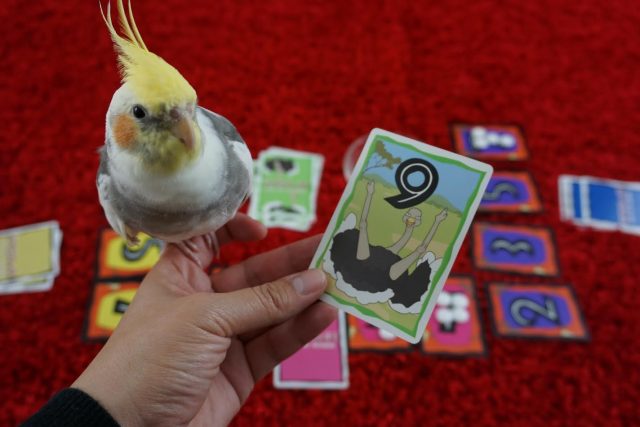
Nettersplays guest star, Gizmo.
Considering most of our writers above had technical jobs, I was curious to see what the spread of employment was like among our videographers. Christian is a mystery, which just makes me more inclined to get it out of him: “ I do have a day job. But if I told you what it was, I’d have to immediately wipe your memory. Company policy.” I bet he’s some sort of board game industry spy. Caryl and Mandi both work here in Canada! Mandi works “in Human Resources for the Federal Government of Canada” which is pretty dang Canadian. Caryl’s got a “few odd jobs, but the main ones would be running my online store and working for Leder Games as their customer service representative. On the side, I do video editing for a real estate company and hopefully more video editing down the line for more game-related content.” The jackpot has been hit, with a hobby blending into work! Annette says for the amount of games she purchases, “I have to have a day job. I work as a hospital physicist for the Radiation Oncology Department in San Francisco … Basically, I operate the particle accelerators to measure the dose that is delivered to ensure accuracy and proper dosage. It can be emotionally hard to work at a cancer center, but there are also plenty of rewards for helping patients receive proper care.” This is amazing. Making content is such an interesting outlet or sidebar to people’s “day jobs”.
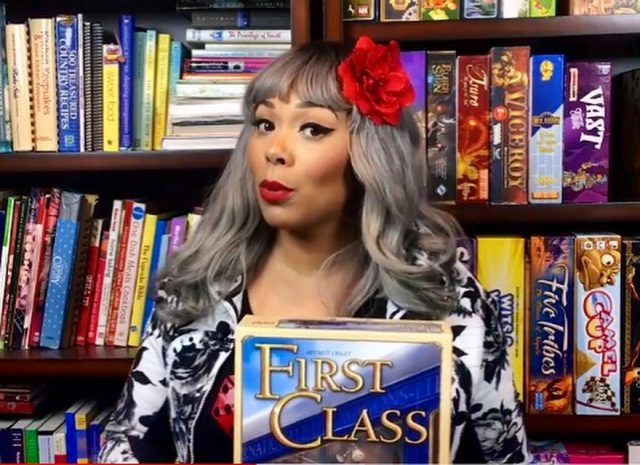
Mandi Hutchinson, Chit Chat with Mandi and Caryl
Considering the incredible variety of video content available out there in board gaming, I asked how these creators choose their content – and discovered that there’s just as much variety for each creator. Caryl & Mandi create for the To Die For Games channel, which has a wide range of stuff. For their particular segment, Chit Chat, focuses on games they like or feel they’d be interested; but also, Caryl says, they “try to be open minded and cover a wide variety of games and look at games that would overall have great qualities, even when they’re not necessarily something we’d pick up ourselves.” Mandi reiterates – “we will try and review games that are not always from well-known companies. We have all started somewhere other than the top, so we try to give opportunities to others that were given to us.” Annette focuses on mainly two sorts of segments – her Acquisitions and Impressions series is a “vlog about the games I purchased in that month. So I follow designers, publishers and other content creators that I know have similar taste to my own for the games that I purchase” while Applied Mechanics focuses in, “I highlight unique mechanisms in games and provide an overview rather than a review.” She will also occasionally put together top 10 videos or a live chat, and crosses paths with Mandi and Caryl also on occasion for the All-Inclusive Gaming Chat so, Mandi says, they “ can talk about board games and potentially, other game-related topics that are not being discussed elsewhere.”
Christian’s videos tend to be far more open-ended and don’t stray near the structure of reviewing and the like – “I’ve never really struggled with coming up with topics and honestly I am coming up with content ideas faster than I can make the videos for them.” He’ll look at how things fit with his channel or recent events in the industry – and says “a good example of this is when there was this big controversy within the board gaming community about a video that Tom Vasel (Dice Tower) made about local game stores and whether or not the bad stores deserved the community’s support. Not surprisingly, this sparked a lot of heated debate. There were lots of pitchforks and a lot of hot takes, but I noticed there wasn’t a balanced, nuanced perspective on the subject so I made a video with that in mind.” It seems whether or not there’s a specific game being focused on, or more broadly a topic or current events, these creators are inspired by what they love and want to share.

Caryl Tan, Chit Chat with Mandi and Caryl
So, who’s involved with making or starring in these videos, and how are things coordinated and made? Annette and Christian are fairly solo creators – although Annette does have the help of her bird friend Gizmo “but he mainly does a lot of behind the scenes work like chewing on my chords and squawking in the middle of my videos.” Christian, while generally being the only person on screen in his content (although recent interview segments have shown some familiar industry faces), says his “wife has had a major role in the development of my content as well though. She’s my toughest critic and my voice of reason.” His coordination is fairly ad hoc, and he says of scheduling, “I don’t really. I mean, my last upload was over a month ago. My life is a hot mess right now.” For Annette, it’s generally easier to create edited content by herself because it’s flexible for time, but joining Mandi and Caryl for the live chats are great “because they are organic and fairly unscripted.”
The dynamic duo of Mandi and Caryl are just one piece of their channel, To Die For Games. Mandi originally started that up and there are a great deal of collaborators overall, but in particular for video, “Caryl Tan, Jen Rabey, Michael Corneau and myself.” For the Chit Chat segment, however, it’s just these two – they first collaborated on a video review of Karuba and Caryl says it “just went from there and [we] found something that worked for us since we live in separate cities and have two wildly different schedules.” Mandi has really dug into the organization for To Die For Games, creating an “Aide Memoire for our team which states all the information that the team needs to know and that includes scheduling” – and the team also uses Trello to track games being covered and deadlines to be met, as well as Slack for generally keeping in touch. As previously mentioned, Mandi and Caryl live in different cities, so when they can get together it’s a mad flurry of playing games, often “about a month’s or so worth of work and content so we can go our separate ways and finish our individual parts separately from our own cities and just come together for the video chat and when it comes to editing,” Caryl says. Being with a core team at the DWP who all live in the same city and have it pretty easy with written work, I can’t imagine how tough this is! And Mandi says “Caryl and I have had a lot of big events happen in our lives, so we had to temporarily step back from creating video content; however, we will be releasing new content in the coming weeks,” which I am looking forward to, knowing all of the intense planning and work going into it.

Christian Kang’s (Take Your Chits) formula for success
Coming out of all of that organization and scheduling, how do these folks determine their video length, if they’re scripted or not – and also, I wondered, if they prefer live or pre-recorded footage? Christian’s videos tend toward the shorter side – “I’m a stereotypical young person with a short attention span, so really, I’m just doing what makes sense to me.” Because of the brevity of his content and favoring pre-recorded content, Christian says he tends to script and over-prepare due to the “tension between wanting to articulate a point as precisely as possible and being as natural and personable as possible.” A focused direction is key. Caryl and Mandi tend toward a little that’s scripted and a little that’s not – Caryl notes “when it comes to a rules overview, for example, scripting it is super important because you want it to be accurate and succinct so you don’t spend 10+ minutes fumbling trying to explain the game or use wrong terms, or even wrong rules,” and for Mandi, key to her is “scripting my Game Play Overviews, so that I don’t include “unnecessary” information.” Beyond that, they aim to keep things chatty and flowing – it’s Chit Chat, after all! Caryl’s “pretty big on just winging our conversation so our discussions stay natural and organic. A lot of the opinions we hear from each other, we hear for the first time as we’re recording too so we can keep reactions genuine.” Overall their segments can go from about 7 – 15 minutes, and ideally under 20 minutes; I liked Mandi’s approach with this, in that “there is no “set” time as we do not expect people to watch the entire video, but to gain something useful for the portions they decide to watch.”
For Annette, timing really depends on the segments she’s producing. “Applied Mechanics is for The Dice Tower’s Board Game Breakfast and there is a limit of 2 minutes … Favorite Game Friday are only a few seconds long and are also produced weekly, but all of the other stuff that I create for my channel are more freeform and varies.” Because Applied Mechanics and Favorite Game Friday are both for other outlets, and even though – as she puts it – “time management is my worst enemy,” Annette tends to plan these into a weekly schedule – and because there really aren’t any deadlines for her other content, they come “in a more sporadic fashion.” While Christian, Mandi and Caryl tend to script, or combine scripting with more off the cuff chatting, all of Annette’s content is on the fly. “When I have used a script, I end up talking like a robot,” she says. “I do make some show notes but it is usually just bullet points that help me organize my thoughts. I think things over before I record, decide what I would like to say and then try to fit it all in one recording session. These recording sessions can take a few minutes or hours depending how well I can get it out and let me tell you editing works wonders.” Let me tell you, that goes for written content absolutely. Oh the rewrites. Annette tends to not prefer either pre-recorded or live content – she enjoys both, and even though she gets butterflies when she goes live it passes; and while there is less room for error with live recordings, Mandi enjoys it “because people get to see you more in your element…not so perfect.” Which is definitely the opposite of written content (unless you’re, say, live tweeting an event or something similar).
So, here’s the big money section as far as this kind of content goes – what’s important to these creators as far as their set up, their skills and tools, and what they’ve learned along the way? One big thing that came up for all of these creators was lighting – especially consistency in lighting. “If you know what you’re doing, you can make great quality videos with a cellphone and a house lamp,” Christian says, but it’s got to be a technique you are comfortable with and can set up to make things look good. I love Annette’s advice that you should just start with what you have and “from there you can find your style and upgrade your equipment as you go. I would suggest trying it out before investing so much money into equipment and software, but rather spend a lot of effort and time thinking about what you would like to create.” Christian’s position is “the single best hardware investment you can make though is a cheap $60 continuous softbox lighting kit from Amazon,” which he uses for his own videos. Annette uses 2 LimoStudio 600w lights with photo studio umbrellas. Beyond the lighting, it’s just trying to find other equipment – cameras and microphones mostly – that you’re comfortable using, rather than a particular piece of technology. From cell phone cameras to webcams to Wifi-enabled video cameras, it all does the job – if you will have a particular focus on audio, Caryl and Mandi use slightly higher level microphones like the Blue Snowball, and lapel microphones for their recording. As for location, Annette says her board game backdrop is key! It can be as simple as that – or, in Mandi’s case, scaled up with a dedicated space: “The flexibility that comes with having a dedicated space to film is extremely useful. I have a studio in my basement that I use to record solo videos, intros and game play overviews. My green screen, lights and video camera are definitely crucial for making my videos come to life.”
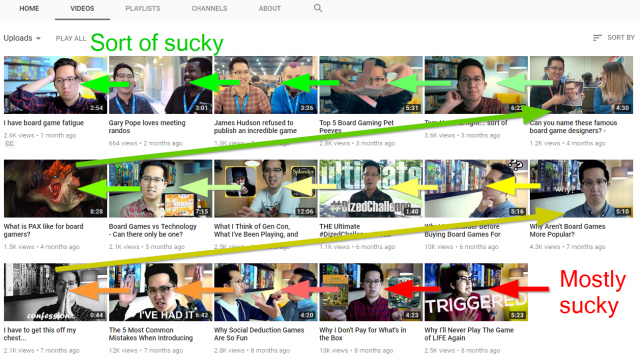
The progress of Take Your Chits over time
The next key skill – and the tools that go with it – focuses on video editing. Christian “started creating content after I swallowed a magical wooden meeple which granted me video editing skills. Just kidding. I learned the editing skills on my own. … Thank goodness anything you want to know or learn is just a simple search away.” For him overall, “the key to my set isn’t actually any piece of hardware, it’s the lighting, editing, colour grading, and storytelling technique that I’ve learned and developed over time.” It definitely sounds like production and editing are a constant learning process. He follows up, “right from the beginning, I knew that it wasn’t the equipment but the technique that was more important. I pushed myself to keep learning more about video production and I think you can see my progression when you go through all of my videos.” Annette had no experience with any aspect of video production, so had to learn on the go; “luckily, I enjoy challenging myself in a creative way and learning how to improve my skills,” and she taught herself how to use Adobe Premiere Pro CC 2017 editing software.While Caryl says you’ll “do fine with basically any editing software you can get your hands on,” she’s “definitely partial to Premiere due to it working best with the rest of the Creative Cloud programs from Adobe, which I crossover work from pretty frequently.” And if you want to get really fancy, and have the time to learn, After Effects is very nice for “polish and flash.” With video, everything was new to her – so even though some skills from using Illustrator and Photoshop transferred over, it’s been a learning experience. Having friends who work in videography and the like, Mandi has been lucky to have been gifted editing programs such as the Adobe Creative Suite – “I implore the use of Adobe Premiere which had quite the learning curve, but, YouTube tutorials are amazing and most helpful …
I worked in theatre, fashion and video, but always in front of the camera, not usually behind the scenes, so there was definitely a lot of getting things wrong and learning from mistakes.” Nobody needs to start as a pro in this field!

Christian Kang, Take Your Chits
Of course, even if you’ve improved enough to start getting pro, there will still be challenges in creating video. For Christian, it’s content related – “it’s easy to come up with ideas. The biggest challenge though is in being able to develop those ideas in a way that is informative and thought-provoking while also being entertaining and relatable.” Personal and time challenges stand out for Annette and Caryl. Time for playing games, on top of everything else – for Annette, who struggles with time management, “not only is it difficult to find the time to produce videos, but you have to be very discipline to maintain continuity.” Caryl agrees, as “keeping up the consistency in the video releases/scheduling is for sure my biggest challenge. It’s hard to juggle life, work, playing the games for review, planning the content, editing and releasing all in the span of a week. To stay relevant, you do have to be consistent and that’s definitely the biggest thing I personally want to improve on.” Mandi’s taken a really big picture approach to the challenges she faces with content production that I really feel can be applied to pretty much any outlet – so I want to wrap this section up with these.
Despite all of the work and challenges faced, what drives and motivates these creators? Christian is overwhelmingly thankful; “I’ve met so many wonderful people through my channel (shoutout to #IncorrigibleClub) and I’m grateful for anyone who takes time out of their day to watch my content, so I want to push myself to continue to create quality content.” The creative process and fun of content creation really drives Caryl. It was all new and exciting, and she “had to learn a million things at once and absorb all these different resources and how-to videos. Being able to achieve something new is definitely a motivation for me, and being able to have control over my work. Sometimes you work so hard for someone else, you just feel free when you do something for yourself and something you’re passionate about.” While sharing her love of board games is a main motivating factor, Annette knows “there are not many content creators that are latina and I want to promote the image that anyone can join in and be a part of this hobby … I find it rewarding to contribute to the board game community and at the same time promote diversity to show that our community is open for everyone to participate and enjoy.” Similarly, Mandi’s “main motivation is that I will make a positive impact on the board gaming community. …There are times where you wonder if it’s worth all of the hard work, but then you remember why you are doing it and it is a great feeling when people who watch/listen to your content appreciate it.”
 For all of these passionate people, it continues to be worth it. Written and video content is a rewarding outlet for these creators, and it’s inspiring to get a glimpse into their experience and process. I really appreciate the hard work that’s put in, the constant learning “on the job” and the way folks really thrive when dipping into all sorts of outlets and different forms of content. The best part of this came from seeing the connections that these creators make with people – their audiences, their fellow gamers, their co-creators, and folks in the industry. I most certainly identify with this and it’s one of the most satisfying outcomes of content creation, and one I never expected to be so enriching. So reach out to your favourite writer or videographer and let them know you have a better understanding of what they do now, and keep them motivated with your feedback!
For all of these passionate people, it continues to be worth it. Written and video content is a rewarding outlet for these creators, and it’s inspiring to get a glimpse into their experience and process. I really appreciate the hard work that’s put in, the constant learning “on the job” and the way folks really thrive when dipping into all sorts of outlets and different forms of content. The best part of this came from seeing the connections that these creators make with people – their audiences, their fellow gamers, their co-creators, and folks in the industry. I most certainly identify with this and it’s one of the most satisfying outcomes of content creation, and one I never expected to be so enriching. So reach out to your favourite writer or videographer and let them know you have a better understanding of what they do now, and keep them motivated with your feedback!
===
Thank you so very much to all of the creators I interviewed for this part 1, for their time and enthusiasm in sharing their process – they gave me so much to work from and I truly barely scratched the surface here. Make sure to check out their stuff, linked below – and give them a follow on Twitter!
Charlie Theel and Rafael Cordero – Ding & Dent, Miniature Market Review Corner, Geek & Sundry @charlietheel @captainraffi
Ruel Gaviola – iSlaytheDragon, Geek & Sundry @ruelgaviola
Eric Yurko – What’s Eric Playing? @whatseplaying
Annette Villa – Nettersplays @nettersplays
Christian Kang – Take Your Chits @takeyourchits
Mandi Hutchinson and Caryl Tan – Chit Chat with Mandi and Caryl @boardgamerpinup @carylhasnotan
[…] peripheral content creators go through as part of their process. Last week, I highlighted those folks producing written and video content. Now, I’m taking a dive into the world of podcasting, as well as folks who are makers – […]
Nicole H., thanks for the article post.Really thank you! Great.
Thank you !!
[…] two part feature interviewing some board-game content creators – first part is those who are videographers and writers and the second is podcasters and makers. It’s interesting to see how processes differ between […]